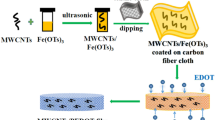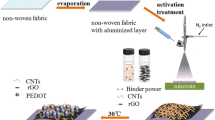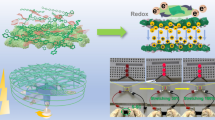Abstract
The design of flexible composite electrodes has become the top priority in energy storage devices for the development of future wearable intelligent electronics. However, searching for fully integrated, ultrathin flexible composite electrodes with satisfying electrochemical performance is still a major challenge. Herein, we introduce a nanoporous gold metallic glass (MG) ribbon-based composite electrode with excellent electric conductivity, mechanical flexibility, and extra capacitance by integrating polypyrrole (PPy) into wrinkled nanoporous ribbon (NPG@MG). The “freestanding, ultrathin, highly conductive and flexible” nature of the composite electrode prevents the conducting polymer from structural instability resulting from the volume swell and shrink during the charging/discharging circulation, and the packed PPy provides protection for the wrinkled topology on the surface of the MG ribbon. The capacitance of pure NPG@MG-PPy composite electrode reached 393 mF·cm−2. The ultra-thin all-solid-state flexible supercapacitor demonstrates an excellent capacitance of 172 mF·cm−2 (14.8 F·cm−3), accompanied by a superior cycling capability after 8000 charge/discharge cycles attributed to mechanical flexibility. The areal energy density also reached 0.74 mWh·cm−3 (9 μWh·cm−2) at a power density of 1 μW·cm−2. This work provides valuable concepts on the design of PPy-based hybrid materials for flexible energy storage systems with greatly enhanced electrochemical performances.
Graphical abstract

摘要
完全集成的超薄柔性超级电容器由于其高功率密度和出色的循环性能, 在可穿戴智能电子产品的日益受到关注。其中聚吡咯 (PPy) 是用于制造柔性超级电容器的超级电容器电极比较有前景的赝电容电极材料, 但由于其有限的电容和较差的循环稳定性, 仍然阻碍了其实际应用。我们在此报告了一种通过将 PPy 结合褶皱纳米多孔金金属玻璃带 (NPG@MG) 作为集流体来开发独立导电复合电极来提高 PPy 电容和循环稳定性的简易策略。具有褶皱突起结构的纳米多孔金非晶玻璃条带表现出高导电性、有效的电荷转移骨架、机械柔韧性、足够的活性表面积和额外的电容提升, 而沉积的 PPy 为金属玻璃带表面的皱纹拓扑结构提供保护。NPG@MG-PPy 复合电极的电容达到 393 mF·cm−2 (33.6 F·cm−3)。使用 NPG@MG-PPy复合电极的全固态柔性超级电容器表现出 172 mF·cm−2 (14.8 F·cm−3) 的优异电容和0.74 mWh·cm−3 (9 μWh·cm−2) 的面能量密度。 在 1 μW·cm−2 的功率密度下, 具有优异的循环能力和机械灵活性。这项工作为设计用于柔性储能系统的 PPy 基杂化材料提供了有价值的概念, 其电化学性能够大大增强。








Similar content being viewed by others
References
Simon P, Gogotsi Y, Dunn B. Where do batteries end and supercapacitors begin? Science. 2014;343(6176):1210. https://doi.org/10.1126/science.1249625.
Simon P, Gogotsi Y. Materials for electrochemical capacitors. Nat Mater. 2008;7(11):845. https://doi.org/10.1038/nmat2297.
Meng F, Ding Y. Sub-micrometer-thick all-solid-state supercapacitors with high power and energy densities. Adv Mater. 2011;23(35):4098. https://doi.org/10.1002/adma.201101678.
Huang Y, Hu H, Huang Y, Zhu M, Meng W, Liu C, Pei Z, Hao C, Wang Z, Zhi C. From industrially weavable and knittable highly conductive yarns to large wearable energy storage textiles. ACS Nano. 2015;9(5):4766. https://doi.org/10.1021/acsnano.5b00860.
Huang Y, Zhu M, Huang Y, Li H, Pei Z, Xue Q, Liao Z, Wang Z, Zhi C. A modularization approach for linear-shaped functional supercapacitors. J Mater Chem A. 2016;4(12):4580. https://doi.org/10.1039/C6TA00753H.
Wang L, Yang H, Liu X, Zeng R, Li M, Huang Y, Hu X. Constructing hierarchical tectorum-like α-Fe2O3/PPy nanoarrays on carbon cloth for solid-state asymmetric supercapacitors. Angew Chem Int Ed. 2017;56(4):1105. https://doi.org/10.1002/anie.201609527.
Zhang Z, Liao M, Lou H, Hu Y, Sun X, Peng H. Conjugated polymers for flexible energy harvesting and storage. Adv Mater. 2018;30(13):1704261. https://doi.org/10.1002/adma.201704261.
Ding Y, Kim YJ, Erlebacher J. Nanoporous gold leaf: “ancient technology”/advanced material. Adv Mater. 2004;16(21):1897. https://doi.org/10.1002/adma.200400792.
Erlebacher J, Aziz MJ, Karma A, Dimitrov N, Sieradzki K. Evolution of nanoporosity in dealloying. Nature. 2001;410(6827):450. https://doi.org/10.1038/35068529.
Fujita T, Guan P, McKenna K, Lang X, Hirata A, Zhang L, Tokunaga T, Arai S, Yamamoto Y, Tanaka N, Ishikawa Y. Atomic origins of the high catalytic activity of nanoporous gold. Nat Mater. 2012;11(9):775. https://doi.org/10.1038/nmat3391.
Wang Z, Ning S, Liu P, Ding Y, Hirata A, Fujita T, Chen M. Tuning surface structure of 3D nanoporous gold by surfactant-free electrochemical potential cycling. Adv Mater. 2017;29(41):1703601. https://doi.org/10.1002/adma.201703601.
Qin C, Zheng D, Hu Q, Zhang X, Wang Z, Li Y, Zhu J, Ou JZ, Yang C, Wang Y. Flexible integrated metallic glass-based sandwich electrodes for high-performance wearable all-solid-state supercapacitors. Appl Mater Today. 2020;19: 100539. https://doi.org/10.1016/j.apmt.2019.100539.
Yao A, Yang H, Wang JQ, Xu W, Huo J, Li RW, Qiu H, Chen M. Flexible supercapacitor electrodes fabricated by dealloying nanocrystallized Al-Ni-Co-Y-Cu metallic glasses. J Alloys Compd. 2019;772:164. https://doi.org/10.1016/j.jallcom.2018.09.090.
Lang X, Hirata A, Fujita T, Chen M. Nanoporous metal/oxide hybrid electrodes for electrochemical supercapacitors. Nat Nanotechnol. 2011;6(4):232. https://doi.org/10.1038/nnano.2011.13.
Fan Z, Yan J, Wei T, Zhi L, Ning G, Li T, Wei F. Asymmetric supercapacitors based on graphene/MnO2 and activated carbon nanofiber electrodes with high power and energy density. Adv Funct Mater. 2011;21(12):2366. https://doi.org/10.1002/adfm.201100058.
He Y, Chen W, Li X, Zhang Z, Fu J, Zhao C, Xie E. Freestanding three-dimensional graphene/MnO2 composite networks as ultralight and flexible supercapacitor electrodes. ACS Nano. 2013;7(1):174. https://doi.org/10.1021/nn304833s.
Huang Y, Huang Y, Zhu M, Meng W, Pei Z, Liu C, Hu H, Zhi C. Magnetic-assisted, self-healable, yarn-based supercapacitor. ACS Nano. 2015;9(6):6242. https://doi.org/10.1021/acsnano.5b01602.
Yao HL, Gao SS, Fu ZQ, Bao WC, Cui ZH, Li YQ, Xu FF. Encapsulating manganese oxide nanoparticles within conducting polypyrrole via in situ redox reaction and oxidative polymerization for long-life lithium-ion batteries. Rare Met. 2021;40(9):2415. https://doi.org/10.1007/s12598-021-01725-0.
Feng X, Huang Y, Li C, Chen X, Zhou S, Gao X, Chen C. Controllable synthesis of porous NiCo2O4/NiO/Co3O4 nanoflowers for asymmetric all-solid-state supercapacitors. Chem Eng J. 2019;368:51. https://doi.org/10.1016/j.cej.2019.02.191.
Kim SI, Lee JS, Ahn HJ, Song HK, Jang JH. facile route to an efficient NiO supercapacitor with a three-dimensional nanonetwork morphology. ACS Appl Mater Interfaces. 2013;5(5):1596. https://doi.org/10.1021/am3021894.
Li H, Li X, Liang J, Chen Y. Hydrous RuO2-decorated MXene coordinating with silver nanowire inks enabling fully printed micro-supercapacitors with extraordinary volumetric performance. Adv Energy Mater. 2019;9(15):1803987. https://doi.org/10.1002/aenm.201803987.
Liu YH, Xu JL, Gao X, Sun YL, Lv JJ, Shen S, Chen LS, Wang SD. Freestanding transparent metallic network based ultrathin, foldable and designable supercapacitors. Energy Environ Sci. 2017;10(12):2534. https://doi.org/10.1039/C7EE02390A.
Jiang SH, Ding J, Wang RH, Chen FY, Sun J, Deng YX, Li XL. Solvothermal-induced construction of ultra-tiny Fe2O3 nanoparticles/graphene hydrogels as binder-free high-capacitance anode for supercapacitors. Rare Met. 2021;40(12):3520. https://doi.org/10.1007/s12598-021-01739-8.
Ning WW, Chen LB, Wei WF, Chen YJ, Zhang XY. NiCoO2/NiCoP@Ni nanowire arrays: tunable composition and unique structure design for high-performance winding asymmetric hybrid supercapacitors. Rare Met. 2020;39(9):1034. https://doi.org/10.1007/s12598-020-01374-9.
Yuan H, Wang G, Zhao Y, Liu Y, Wu Y, Zhang Y. A stretchable, asymmetric, coaxial fiber-shaped supercapacitor for wearable electronics. Nano Res. 2020;13(6):1686. https://doi.org/10.1007/s12274-020-2793-x.
Wu C, Zhang Z, Chen Z, Jiang Z, Li H, Cao H, Liu Y, Zhu Y, Fang Z, Yu X. Rational design of novel ultra-small amorphous Fe2O3 nanodots/graphene heterostructures for all-solid-state asymmetric supercapacitors. Nano Res. 2021;14(4):953. https://doi.org/10.1007/s12274-020-3131-z.
Huang Y, Tao J, Meng W, Zhu M, Huang Y, Fu Y, Gao Y, Zhi C. Super-high rate stretchable polypyrrole-based supercapacitors with excellent cycling stability. Nano Energy. 2015;11:518. https://doi.org/10.1016/j.nanoen.2014.10.031.
Huang Y, Zhong M, Huang Y, Zhu M, Pei Z, Wang Z, Xue Q, Xie X, Zhi C. A self-healable and highly stretchable supercapacitor based on a dual crosslinked polyelectrolyte. Nat Commun. 2015;6(1):10310. https://doi.org/10.1038/ncomms10310.
Huang Y, Zhu M, Pei Z, Xue Q, Huang Y, Zhi C. A shape memory supercapacitor and its application in smart energy storage textiles. J Mater Chem A. 2016;4(4):1290. https://doi.org/10.1039/C5TA09473A.
Jiang K, Baburin IA, Han P, Yang C, Fu X, Yao Y, Li J, Cánovas E, Seifert G, Chen J, Bonn M. Interfacial approach toward benzene-bridged polypyrrole film-based micro-supercapacitors with ultrahigh volumetric power density. Adv Funct Mater. 2020;30(7):1908243. https://doi.org/10.1002/adfm.201908243.
Sun J, Huang Y, Fu C, Wang Z, Huang Y, Zhu M, Zhi C, Hu H. High-performance stretchable yarn supercapacitor based on PPy@CNTs@urethane elastic fiber core spun yarn. Nano Energy. 2016;27:230. https://doi.org/10.1016/j.nanoen.2016.07.008.
Liu N, Ma W, Tao J, Zhang X, Su J, Li L, Yang C, Gao Y, Golberg D, Bando Y. Cable-type supercapacitors of three-dimensional cotton thread based multi-grade nanostructures for wearable energy storage. Adv Mater. 2013;25(35):4925. https://doi.org/10.1002/adma.201301311.
Wang HB, Tian HY. MnO2/active carbon as supercapacitors electrode doped with rare metal. Chin J Rare Met. 2007;31(2):197. https://doi.org/10.13373/j.cnki.cjrm.2007.02.013.
Tian W, Mao X, Brown P, Rutledge GC, Hatton TA. Electrochemically nanostructured polyvinylferrocene/polypyrrole hybrids with synergy for energy storage. Adv Funct Mater. 2015;25(30):4803. https://doi.org/10.1002/adfm.201501041.
Boota M, Anasori B, Voigt C, Zhao MQ, Barsoum MW, Gogotsi Y. Pseudocapacitive electrodes produced by oxidant-free polymerization of pyrrole between the layers of 2D titanium carbide (MXene). Adv Mater. 2016;28(7):1517. https://doi.org/10.1002/adma.201504705.
Zhu M, Huang Y, Deng Q, Zhou J, Pei Z, Xue Q, Huang Y, Wang Z, Li H, Huang Q, Zhi C. Highly flexible, freestanding supercapacitor electrode with enhanced performance obtained by hybridizing polypyrrole chains with MXene. Adv Energy Mater. 2016;6(21):1600969. https://doi.org/10.1002/aenm.201600969.
Liu T, Finn L, Yu M, Wang H, Zhai T, Lu X, Tong Y, Li Y. Polyaniline and polypyrrole pseudocapacitor electrodes with excellent cycling stability. Nano Lett. 2014;14(5):2522. https://doi.org/10.1021/nl500255v.
Song Y, Liu TY, Xu XX, Feng DY, Li Y, Liu XX. Pushing the cycling stability limit of polypyrrole for supercapacitors. Adv Funct Mater. 2015;25(29):4626. https://doi.org/10.1002/adfm.201501709.
Otero TF, Alfaro M, Martinez V, Perez MA, Martinez JG. Biomimetic structural electrochemistry from conducting polymers: processes, charges, and energies. Coulovoltammetric results from films on metals revisited. Adv Funct Mater. 2013;23(31):3929. https://doi.org/10.1002/adfm.201203502.
Neoh KG, Kang ET, Tan KL. Limitations of the X-ray photoelectron spectroscopy technique in the study of electroactive polymers. J Phys Chem B. 1997;101(5):726. https://doi.org/10.1021/jp962497y.
Huang Y, Zhu M, Pei Z, Huang Y, Geng H, Zhi C. Extremely stable polypyrrole achieved via molecular ordering for highly flexible supercapacitors. ACS Appl Mater Interfaces. 2016;8(3):2435. https://doi.org/10.1021/acsami.5b11815.
Huang Y, Li H, Wang Z, Zhu M, Pei Z, Xue Q, Huang Y, Zhi C. Nanostructured polypyrrole as a flexible electrode material of supercapacitor. Nano Energy. 2016;22:422. https://doi.org/10.1016/j.nanoen.2016.02.047.
Xia Q, Xia T, Wu X. PPy decorated α-Fe2O3 nanosheets as flexible supercapacitor electrodes. Rare Met. 2022;41(4):1195. https://doi.org/10.1007/s12598-021-01880-4.
Wang Z, Tammela P, Zhang P, Strømme M, Nyholm L. High areal and volumetric capacity sustainable all-polymer paper-based supercapacitors. J Mater Chem A. 2014;2:16761. https://doi.org/10.1039/C4TA03724C.
Zhang J, Chen P, Oh BH, Chan-Park MB. High capacitive performance of flexible and binder-free graphene–polypyrrole composite membrane based on in situ reduction of graphene oxide and self-assembly. Nanoscale. 2013;5:9860. https://doi.org/10.1039/C3NR02381H.
Acknowledgements
This work was financially supported by the National Natural Science Foundation of China (Nos. 21905180 and 51873108), Shenzhen Science and Technology Planning Project (Nos. JCYJ20200109141640095 and JCYJ20170817110251498) and Guangdong-Hong Kong-Macao Joint Laboratory (No. 2019B121205001). All HAADF-STEM, and EDS mapping were supported by Centre for Advanced Research of Energy and Materials in Division of Quantum Science and Engineering, Faculty of Engineering, Hokkaido University. We acknowledge Dr. Yukun Wang and Dr. Zhuoxin Liu of Prof. Chunyi Zhi’s group in City University of Hong Kong for the discussion and support of PPy deposition.
Author information
Authors and Affiliations
Corresponding authors
Ethics declarations
Conflict of interests
The authors declare that they have no conflict of interest.
Supplementary Information
Below is the link to the electronic supplementary material.
Rights and permissions
About this article
Cite this article
Xu, Y., Yiu, P.M., Wang, YK. et al. Highly flexible, mechanically strengthened metallic glass-based composite electrode with enhanced capacitance and cyclic stability. Rare Met. 41, 3717–3728 (2022). https://doi.org/10.1007/s12598-022-02060-8
Received:
Revised:
Accepted:
Published:
Issue Date:
DOI: https://doi.org/10.1007/s12598-022-02060-8




